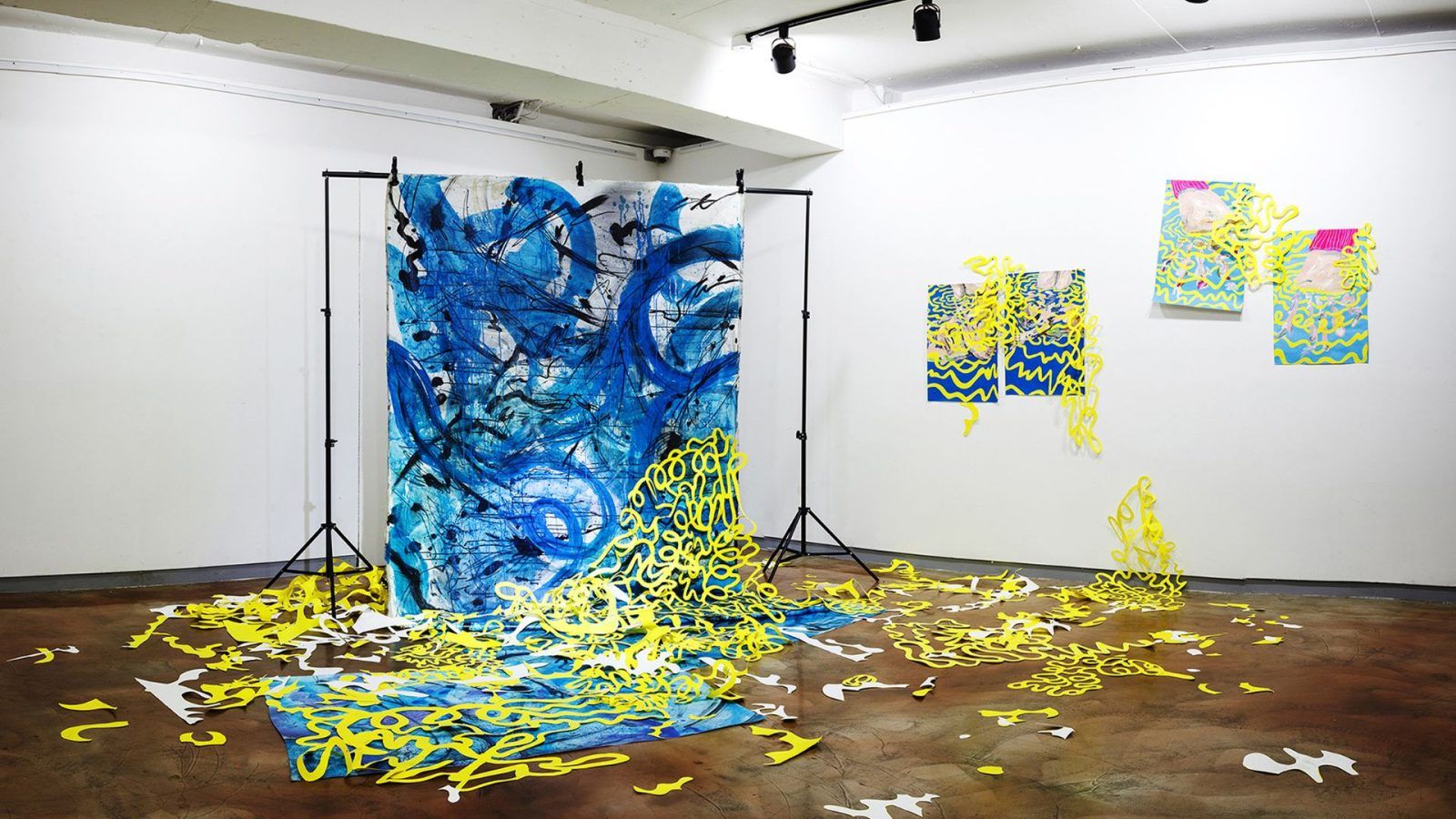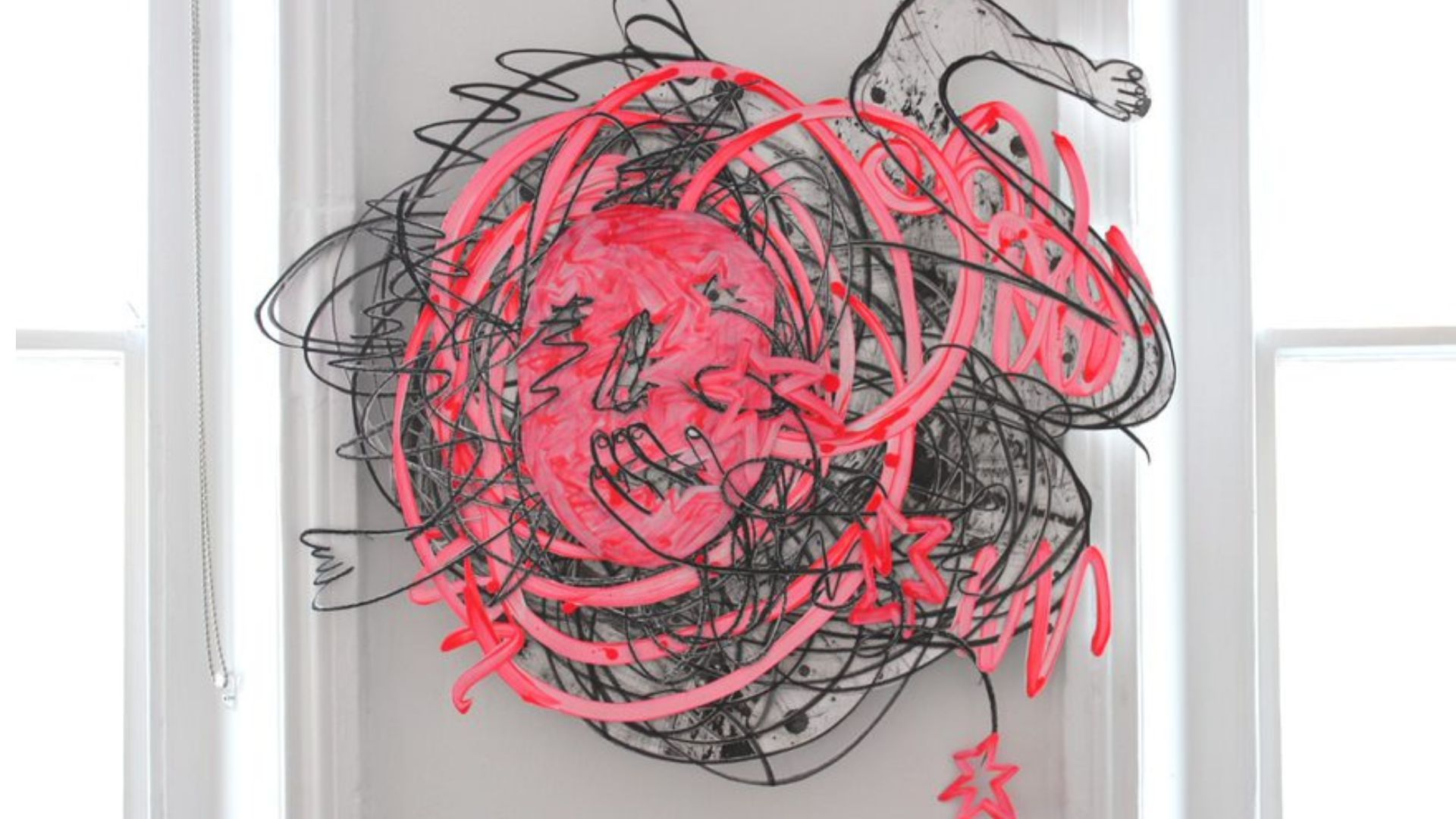Korean Female Artists Create Buzz in London


Art, but not as we know it. Three London-based Korean female artists are shifting the visual syntax.
While South Korean cultural K-waves surge around the globe on the currents of K-pop (Blackpink, BTS) and K-cinema’s dual Oscar-winners, director (Bong Joon-ho, Parasite) and veteran actress (Youn Yuh-jung, Minari), propelled by swathes of fandom on social-media platforms, there’s a mini K-wave rippling through London, one driven by a trio of young contemporary female artists – Hee Jyung Kim, Minyoung Kim and Yeonsu Ju – who one way or another are creating buzz in the capital and beyond.
In the case of Hee Jyung Kim, fresh off a first solo show where she took over the space at London’s Coups Contemporary gallery, the waves are ever-present. This writer first saw her work at Saatchi Gallery’s London Grads Now 21 show, an impromptu gathering of the capital’s art students whose production had been stifled by Covid, where the effect was powerful. Set back in one of the large spaces and dwarfed by larger pieces, Kim’s work pulsed with a quiet energy.

Hockney-esque Beverley Hills pools saturated by the static, artificial, almost frozen qualities of a lifestyle platform. Kim’s pool was awash with yellow waves, agitated like static, zig-zagging their way across the blue water’s surface. It looked as if the pool had been struck by lightning. (And it looked as natty and sharp and design-y as a Matisse, and felt a lot like how the soundwaves of Edvard Munch’s The Scream might appear were they transposed to water.) And yet curiously, the anonymous personage in the pool appeared at ease despite the watery K-fuffle. Calm in a moment of crisis, it felt oddly zeitgeistful in the context of the show.
Kim, a Slade School of Fine Art graduate, got the aquatic habit when she returned to South Korea, mid-pandemic, pre-graduation from London. “I went to the Han River in Seoul – there are lots of waterfalls and it’s like a way to heal yourself. I saw the people around the waterfall, just watching the water. It’s really just nature being nature, but everybody comes to see it. That gave me lots of inspiration – and a direction. Particularly, the idea of water, or flowing water, not being still or static, and how it represents freedom of the mind and spirit.” Those chevronic yellow waves, she explains, “are symbols or barriers of anxiety in our lives”, noting that yellow correlates to anxiety in psychology. “I want to express the moment when I dream of breaking down difficulties psychologically by thinking about the boundaries between our reality and a world of liberation.”

Several months later this writer dropped into D-Contemporary in the salubrious surrounds of Mayfair’s Bruton Street, next door to David Zwirner and 20 metres from Spruth Maygers. And, lo and behold, the wave struck again. But this time, a different point of view, fully immersed in the pool and only a pair of feet floating – or drowning – amid that anxious but dandy yellow chevronery. Unmistakably Hee Jyung Kim.
And on the wall directly opposite, a “cut-out” (like Matisse, Kim cuts paper to make her art), bustling with the accelerated energy of a whirling dervish, seemingly fighting its way off the wall in a hurricane, in the form of an abstracted portrait of a person. Kim calls these “characters”. She assembles them in sections, or waves, or layers built one on top of another, like vertical biographical chapters. In publishing we call such technique (and it’s rare) a vertical gatefold, i.e, pages that you don’t turn horizontally left or right outside of the magazine, but simply lift vertically out of it.
Oodles of technique and panache flow through the cut-outs’ construction, with waves of the Gutai school of art. (Gutai was a Japanese avant-garde group formed in 1954, whose radical ideas and approaches to making art pre-empted performance and conceptual art in the 1960s and ’70s.) “The cut-outs are characters, but I make them abstract, so it’s a very active style of making – and fun,” Kim says. “My movements are spontaneous and energetic when I create them – and the pulling and stretching is very Gutai, with a strong performance aspect.” Are they self-portraiture? No. “Each collage is a person, an abstract human being.”

Despite their ferocious, provocative and primal nature, much like pioneering Gutai artist Kazuo Shigara, Kim’s work also shares with his an exhilarating grace. Whirls, slashes and smears of electric reds, neon pinks and cerulean blues are punctuated with splashes of inky black, in visual pyrotechnics. Shiraga was legendary for applying paint with his feet while swinging on a rope hung from the ceiling of his atelier. While Kim isn’t yet swinging barefoot from the chandeliers of her minuscule Battersea studio, feet do figure in several of her works, including D-Contemporary and her show at Coups, where they’ve been both the subject of the yellow waves and visible in the kinetic cut-outs. “When it comes to feet,” Kim says, “I believe these parts of the body we don’t care so much about are the most honest parts of our body. And they carry our narrative history as humans. That’s why I use them so often in my painting.
A visit to Kim’s studio is revealing. She has portraits, sculpture, ceramic and all manner of artwork. “I can do abstract, but it’s something that doesn’t interest me all the time,” she says. And there’s not a frame in sight. “I don’t like frames around my paintings, the feeling is too constraining. These kinds of works, I just have to let them go.” It comes in waves, I suppose; kinetic, frenetic, Zen-etica.
Whereas Hee Jyung Kim lets the leash off, Kim Minyoung, familiar to Hong Kong audiences for a group show at Kevin Poon’s Woaw gallery last October, is linear as a laser, strategic as a spreadsheet, yet playful and oh-so purr-fectly dark, in terms of her “brand management”. Like her namesake, Minyoung’s a 2021 Slade School of Fine Art graduate (with distinction), defined by signature black cats in multiple guises, moonlit land- and seascapes, impassive fish, sibilant serpents, and even anthropomorphic food (her dim sum, xiao long bao and gyoza bear smiling faces); through it all, she plays the mystical, fable-esque storytelling alchemist with the elevated dexterity of a visual Roald Dahl. She’s also prodigiously well-read, with deep knowledge of Korean philosophers and a predilection for two writer-poets, Park Seo Young and Lee Eun Kyu.
As recently as last month (January 17-20), Kim exhibited new work at the London Art Fair via Cactus Moon Studio; black-and-white sketches of her capricious cats, along with an innovative series of three jacquard-woven soft tapestries, based on original paintings featuring her mischievous felines. The high-quality machine-weaving technique paralleled Kim’s refined painterly gestures. And tantalising lifestyle trope: the works make for eye-catching wall hangings, cosy blankets or bedspreads. And without wishing to over-commoditise the artist’s nascent but rapidly expanding oeuvre, I’d have welcomed some Kimesque cushions to curl up with and get all purr-y over.
“Sometimes my ideas are very vague, or I dream about different things, like, Alice in Wonderland, or about subjects from Korean poems and they’ll be weird features or moments,” she tells me from her studio overlooking the Tower of London. (No better place for storytelling.) Along with upcoming shows in London, she’s also exhibiting at Tokyo’s JPS Gallery in September.
Meantime she’s courting ambiguity, which she regards as integral to her work. “My fish are ambiguous and passive, like a helpless watching public; the snake has a kind of ambivalence, despite being very fertile and laying so many eggs; the cat changes in appearance but is neither obviously male or female, and the moon changes every day. So I like the fact that ambiguity runs through my work, and the contradiction that creates in my painting.” Like it – we love it.
Minyoung’s identity shifts across her work, too; sometimes a mermaid, a knife-wielding woman – and she expresses a liking for American artist Gertrude Abercrombie, whose work was associated with witchcraft. Does she feel a sorceress’s lure; is she a witch disguised as the black cat? “Sometimes I am the cat,” she says, and pauses. “But, I’m thinking about being a witch in my painting sometimes, because the witch is a lonely being who suffered from a lot of prejudice in the past.” I sense her conjuring. “But I don’t know what kind of face the witch or witches would have yet. I want to explore them more, and hope I can illustrate their appearance in the future.” Witch out!
I find myself with Ju Yeonsu at her St Pancras/King’s Cross studio, examining her latest paintings in their differing states of evolution, completion or abandonment. I’m complementing one work, Francis Bacon in My Kitchen (2022), which formed part of her inaugural solo show Eating is Mutual at The Room London gallery, in which she’d depicted the artist on all fours in tortured guise. “Why Bacon?” I ask, expecting her to reference last year’s Royal Academy exhibition on the British master, Yet her
answer turns the moment italic. “Do you know a Korean song called “Zutter”, by G-Dragon and T.O.P”? Humbled and honoured, I admit I don’t, despite Prestige having run T.O.P as its much-heralded and -referenced March 2022 cover. “At one point, T.O.P sings [she translates] … Da Vinci has come back to life / Francis Bacon in my kitchen / I’m like Calder [Alexander] dancing on top of your head…
She laughs. “I thought, why not? If T.O.P can have a Francis Bacon on his kitchen fridge, then why shouldn’t I improvise in the same way?” Moment. [Can we have a Ju Yeonsu lightstick please?] For Ju, younger (twentysomething) than the two Kims (earlythirtysomething), accolades have come thick and fast. She’s the winner of the 10th Anniversary Window Project at Gazelli Art House in Mayfair, and was shortlisted for Bloomberg New Contemporaries 2021. She’s exhibited with HdM Gallery in London and has forthcoming shows at KIAF, Seoul; Art Busan; and ASC Gallery London, among others.

The Korean female artist paints bold, sensorial pictures suffused with literary, epicurean, fashion-y, “Love in Full Bloomsbury” vibes. She treats eyes as energy centres and enhances them with strips of paint like exaggerated eyelashes. (I’m reminded of Hee Jyung Kim’s
yellow waves.) A sumptuous painting dries in front of us. “Oh, this was based on a photograph I took as I walked past a beautiful display in the Liberty store window – with lights, cups, décor,” she explains.
Ju studied sociology in Seoul before changing tack midway. Watching her younger sister paint had stoked her curiosity. “I thought maybe I should explore the hobby, and it’s one I love very much.” So she did, graduating from the Glasgow School of Art in 2021 with a BA in Painting and Printmaking, and is now completing a Masters in Painting at Slade.
Hew Hood, London-based former fashion stylist, photographer and owner of The Room London gallery, discovered Ju on digital. “I first came across Yeonsu’s work on Instagram, I was instantly in love with her work, and one painting called She Brings the Rain. I felt her work was full of energy and life.” The show was a sell-out. “What’s been so lovely is seeing how Yeonsu’s work has developed over the year. It’s more confident, experimental and becoming very much a unique style to Yeonsu. I’ll have her back in The Room London in July for a future group show called Windows.”

Art’s fast-forwarded future’s on the move, collectors. Vibe to this wave-making trio of K-art stars and their energetically charged tales of the unexpected.